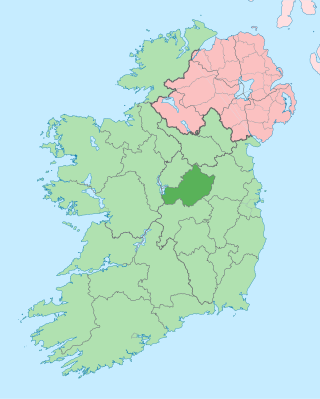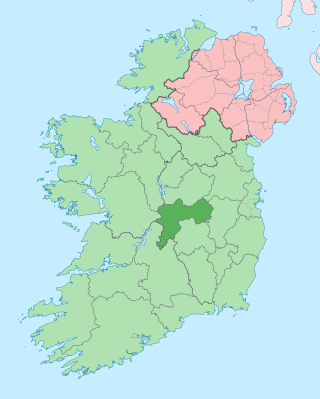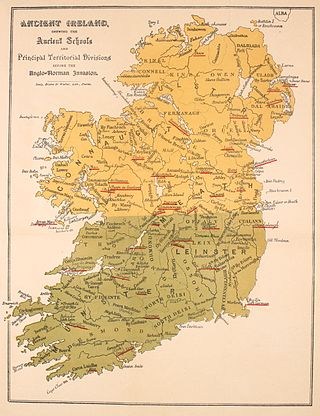
An esker, eskar, eschar, or os, sometimes called an asar, osar, or serpent kame, is a long, winding ridge of stratified sand and gravel, examples of which occur in glaciated and formerly glaciated regions of Europe and North America. Eskers are frequently several kilometres long and, because of their uniform shape, look like railway embankments.

County Westmeath is a county in Ireland. It is in the province of Leinster and is part of the Eastern and Midland Region. It formed part of the historic Kingdom of Meath, which was named Mide because the kingdom was located in the geographical centre of Ireland. Westmeath County Council is the administrative body for the county, and the county town is Mullingar. At the 2022 census, the population of the county was 95,840.

County Offaly is a county in Ireland. It is part of the Eastern and Midland Region and the province of Leinster. It is named after the ancient Kingdom of Uí Failghe. It was formerly known as King's County, in honour of Philip II of Spain. Offaly County Council is the local authority for the county. The county population was 82,668 at the 2022 census.

Kilbeggan is a town in County Westmeath, Ireland. It is in the barony of Moycashel.

Clara is a town on the River Brosna in County Offaly, Ireland. It is the 10th largest town in the midlands of Ireland. The town had a population of 3,403 as of the 2022 census.
The 2005 All-Ireland Senior Hurling Championship was the 119th staging of the All-Ireland Senior Hurling Championship, the Gaelic Athletic Association's premier inter-county hurling tournament, since its establishment in 1887. The draw for the provincial fixtures took place on 17 October 2004. The championship began on 15 May 2005 and ended on 11 September 2005.

Leath Cuinn and Leath Moga are legendary ancient divisions of Ireland, respectively north and south of a line corresponding to the Esker Riada running east–west from Dublin Bay to Galway Bay. The eponymous Conn and Mug were Conn Cétchathach and Éogan Mór Mug Nuadat, whose armies in 123 AD fought the battle of Mag Lena.
The Camogie All Star Awards are awarded each November to 15 players who have made outstanding contributions to the Irish stick and ball team sport of camogie in the 15 traditional positions on the field: goalkeeper, three full backs, three half-backs, two midfields, three half-forwards and three full-forwards. They were awarded for the first time in 2003 as an independent initiative sponsored by a hotel group and accorded official status by the Camogie Association in 2004.
The 1962 All-Ireland Senior Hurling Championship was the 76th staging of the All-Ireland hurling championship since its establishment by the Gaelic Athletic Association in 1887. The championship began on 15 April 1962 and ended on 2 September 1962.

There have been routes and trackways in Ireland connecting settlements and facilitating trade since ancient times and the country now has an extensive network of public roads connecting all parts of the island.
In Irish mythology, Éber Donn is the eldest son of Míl Espáine, the mythical ancestor of the Irish people. Unlike his brothers, Eremon, Éber Finn and Amergin, Éber Donn was unable to land in Ireland, and was killed by a shipwreck off the island's southwest coast. As reported by Lebor Gabála Érenn, Éber Donn slighted the goddess Ériu, who predicted that neither he nor his offspring would land safely on the soil of Ireland. He was buried by his brothers in Tech Duinn, a rocky island off the Irish coast.

Some historical calendars had "weeks" consisting of eight days.
The 2016 All-Ireland Senior Hurling Championship was the 129th staging of the All-Ireland championship since its establishment by the Gaelic Athletic Association in 1887. It is the top tier of senior inter-county championship hurling.
The 2017 National Football League, known for sponsorship reasons as the Allianz Football League, was the 86th staging of the National Football League, an annual Gaelic football tournament for Gaelic Athletic Association county teams. Thirty-one county teams from the island of Ireland, plus London, compete. Kilkenny do not participate.
The 2018 All-Ireland Senior Hurling Championship was the 131st staging of the All-Ireland Senior Hurling Championship since its establishment by the Gaelic Athletic Association in 1887. It is the first tier of senior inter-county championship hurling.
The 2019 National Football League, known for sponsorship reasons as the Allianz National Football League, was the 88th staging of the National Football League (NFL), an annual Gaelic football tournament for Gaelic Athletic Association county teams. Thirty-one county teams from the island of Ireland, plus London, competed; Kilkenny do not participate.
Kathleen "Kate" Mulchrone was an Irish Celtic scholar.

High Street is a street in the medieval area of Dublin, Ireland.

The 2023 All-Ireland Senior Hurling Championship was the 136th staging of the All-Ireland Senior Hurling Championship, the Gaelic Athletic Association's premier inter-county hurling tournament, since its establishment in 1887. The championship began in April 2023 and ended on 23 July 2023.
Mag Lena, Mag Léna, or Mag Léne was the name of a plain or heath in the Gaelic Irish territory of Firceall, between modern Tullamore and Durrow in County Offaly. Mag Lena straddled the Esker Riada, was near the border between Mide and Laigin (Leinster), and is mentioned in Irish manuscripts as the site of several legendary, pseudohistorical, and historical events. The civil parish of Kilbride in Ballycowan was "Kilbride al[ias] Moylena" in the time of Charles I. According to John O'Donovan, the name Moleany was still being used in 1837 for the corresponding Catholic parish. By then the area was agricultural rather than heathland.










